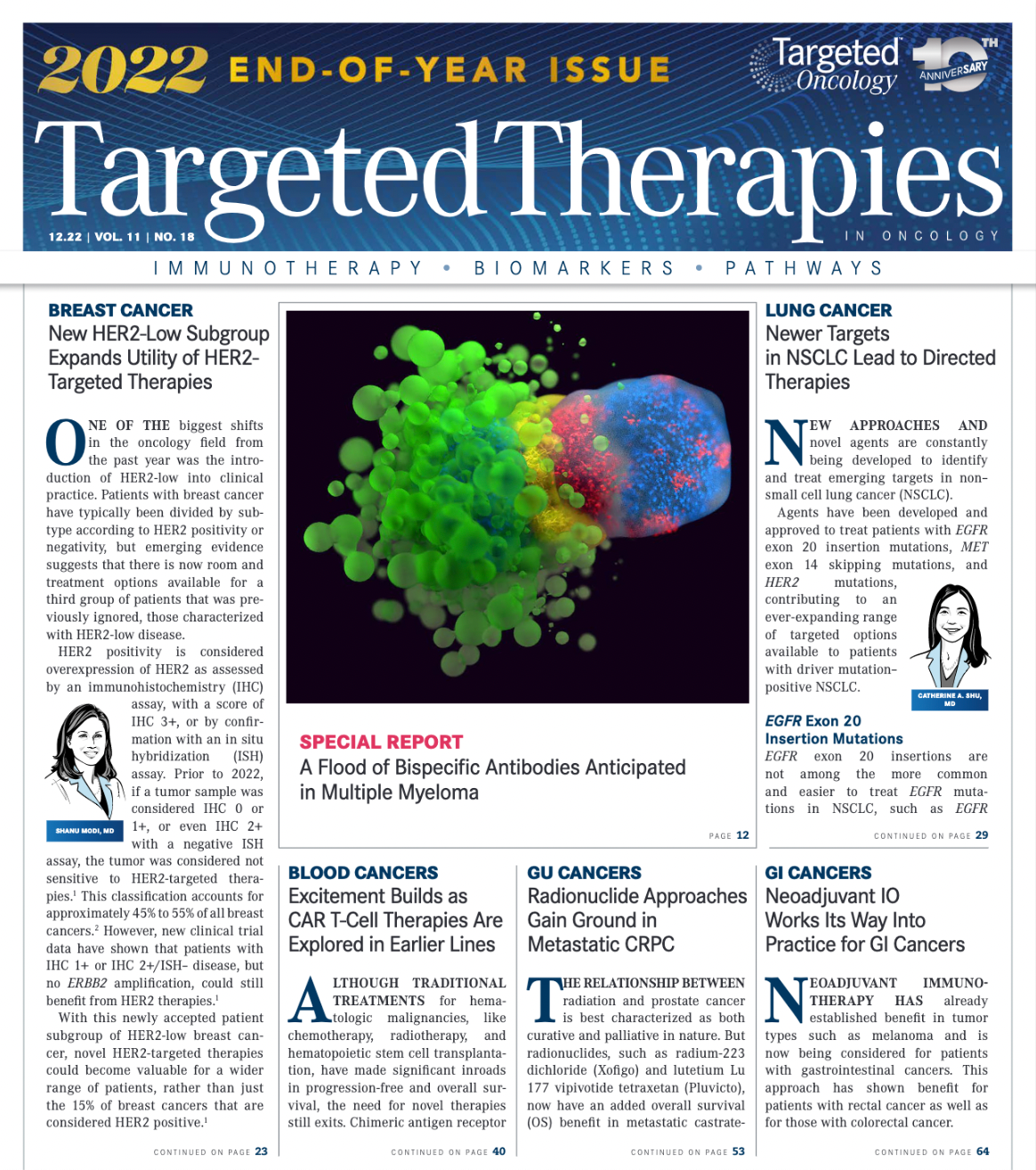Radionuclide Approaches Gain Ground in Metastatic CRPC
Radionuclides, such as radium-223 dichloride and lutetium Lu 177 vipivotide tetraxetan, now have an added overall survival benefit in metastatic castrate-resistant prostate cancer.

The relationship between radiation and prostate cancer is best characterized as both curative and palliative in nature. But radionuclides, such as radium-223 dichloride (Xofigo) and lutetium Lu 177 vipivotide tetraxetan (Pluvicto), now have an added overall survival (OS) benefit in metastatic castrate-resistant prostate cancer (mCRPC), according to Scott Tagawa, MD, MS, FACP, during a presentation at the 40th Annual CFS®, in which he provided an overview of the current radionuclide paradigm in prostate cancer.1
Radium-223
The approval of radium-223 was based on findings from the ALSYMPCA trial (NCT00699751), which evaluated 921 patients randomly assigned 2:1 to receive radium-223 (50 kBq/kg IV) plus best standard of care vs placebo.2,3
The interim analysis (n = 809) demonstrated that radium-223 significantly improved OS (median, 14.0 months) vs placebo (median, 11.2 months), respectively (HR, 0.70; 95% CI, 0.55-0.88; P = .002). The updated analysis (n = 921) confirmed the radionuclide’s survival benefit vs placebo, median 14.9 months vs 11.3 months, respectively (HR, 0.70; 95% CI, 0.58-0.83; P < .001).3
Turning to metastatic prostate cancer, Tagawa noted that in bone metastases, a number of factors come into play. These include osteoclasts, the immune system, endothelial cells, stromal cells, and osteoblasts.
“Radium-223 only affects a small number of these factors, making concomitant therapies an important consideration to explore,” said Tagawa, a professor of medicine and urology, Weill Cornell Medicine, and attending physician, NewYork- Presbyterian/Weill Cornell Medical Center in New York, New York, during his presentation.
Concomitant Therapies
Findings from an international, prospective, interventional, open-label, single-arm, phase 3b study (NCT01618370) showed that radium-223 can be safely combined with abiraterone (Zytiga) or enzalutamide (Xtandi).4
Patients received up to 6 IV injections of radium-223, 50 kBq/kg every 4 weeks. Other concomitant anticancer therapies were allowed. The primary end points were safety and OS. Investigators reported that median OS was longer for patients with baseline alkaline phosphatase concentration that was less than the upper limit of normal (ULN) than for patients with alkaline phosphatase concentration equal to or greater than the ULN; patients with baseline hemoglobin levels of 10 g/dL or greater; and for patients who reported no baseline pain.
Median OS was also longer in patients who received radium-223 plus abiraterone, enzalutamide, or both than in those who did not receive the agents.
The ERA 223 trial (NCT02043678) randomly assigned 806 patients 1:1 to receive either radium-223 plus abiraterone and prednisone or prednisolone vs placebo plus abiraterone and prednisone or prednisolone.5
The primary end point was symptomatic skeletal event-free survival, which was assessed in the intention-to-treat population. Safety analyses were performed in all patients who received at least 1 dose of any study drug.
Investigators reported that the median symptomatic skeletal event-free survival was 22.3 months (95% CI, 20.4-24.8) in the radium-223 group and 26.0 months (95% CI, 21.8-28.3) in the placebo group (HR, 1.1; 95% CI, 0.917-1.374; P = .264). Fractures (any grade) occurred in 112 (29%) of 392 patients in the radium-223 group and 45 (11%) of 394 patients in the placebo group.
“Although these results from ERA 223 were negative, it has become clear that bone health agents are mandatory. Radium-223 leads to a survival benefit, but avoid prescribing abiraterone/prednisone with the agent; other combinations are undergoing study,” Tagawa said.
177Lu-PSMA-617
Turning to radioligand therapy (RLT), Tagawa emphasized that prostate-specific membrane antigen (PSMA) remains a target of high interest in the current era, especially in the setting of aggressive, metastatic prostate cancer.
The factors that contribute to PSMA’s role in treatment include its being well established, validated in cells and in humans in the clinic; prostate restricted with distribution mostly limited to the prostate gland and to prostate cancer; and presence on the surface of prostate cancer cell membranes. Tagawa highlighted the numerous agents undergoing evaluation including 177Lu-PNT2002, and 177Lu-J591 (rosopatamab; formerly TLX591) in phase 3 trials.
A German multicenter trial of 177Lu-labeled PSMA-617 evaluated 145 patients with mCRPC in a pooled retrospective analy-sis to determine safety and efficacy.6 The primary end point for efficacy was biochemical response as defined by a prostate-specific antigen (PSA) decline of 50% or greater from baseline to at least 2 weeks after the start of radioligand therapy.
Grade 3 to 4 hematotoxicity occurred in 18 patients with the most common being anemia (10%), thrombocytopenia (4%), and leukopenia (3%). The overall biochemical response rate was 45% after all therapy cycles, and 40% of patients had already responded after a single cycle.
A study from Australia (Australian New Zealand Clinical Trials Registry 12615000912583) provided prospective data from a single-arm, single-center, phase 2 trial. Forty-three men were screened and 30 were eligible for the study. Objective response in nodal or visceral disease was reported in 14 (82%) of 17 patients with measurable disease. Clinically meaningful improvements in pain severity and interference scores were recorded at all time points. Eleven (37%) patients experienced a 10-point or more improvement in global health score by the second cycle of treatment, according to investigators.
Previous treatment history showed that 26 patients (87%) had received at least 1 line of either docetaxel or cabazitaxel (Jevtana) and 25 patients (83%) had received prior abiraterone acetate, enzalutamide, or both.
These findings led investigators to launch the VISION and TheraP trials (NCT03511664 and NCT03392428, respectively).7,8
VISION and TheraP Trials
The phase 3 VISION trial randomly assigned patients with mCRPC who were PSMA-positive 2:1 to receive best supportive care/ standard-of-care therapy with or without 177lutetium-PSMA-617 once every 6 weeks for 6 cycles. Patients had previously been treated with 1 or 2 taxane-based regimens and androgen-receptor targeted therapy. The primary end points were radiographic progression-free survival (rPFS) and OS.
Those in the treatment arm had a 38% improvement in OS, with a median OS of 15.3 months vs 11.3 months with standard of care. Their rPFS was improved by 60%, with a median of 8.7 months with 177Lu-PSMA-617 vs 3.4 months with standard of care. A secondary end point of time to first symptomatic skeletal event was 11.5 months vs 6.8 months, respectively.
The TheraP trial compared 177Lu- PSMA-617 with cabazitaxel. Patients in the treatment arm had a much higher chance of PSA response, 66% vs 37%, than patients in the control arm. These patients also had a PSA reduction of 50% or more compared with the control arm.
Looking to the Future
Tagawa said now that RLT has been established, a number of constructs are on the horizon. These include beta- and alpha-radiolabeled products, combinations involving androgen-receptor pathway agents, immunotherapy agents, and PARP inhibitors.
Efforts to determine the efficacy of moving PSMA treatments to earlier in the disease cycle are also being explored in a number of trials. Among those are PSMAfore (NCT04689828), SPLASH (NCT04647526), ECLIPSE (NCT05204927), and PROSTACT (NCT04876651).
“PSMA is a clinically validated cell-surface target that is relevant in the current era,” Tagawa concluded.
REFERENCES:
1. Tagawa ST. Emerging therapeutic radionuclides for advanced prostate cancer. Presented at: 40th Annual CFS®; November 9-11, 2022; New York, NY and virtual. Accessed November 11, 2022. http://bit. ly/3UQeQcK
2. Bayer receives U.S. FDA approval for Xofigo (radium Ra 223 dichloride) injection as a new treatment for castration-resistant prostate cancer with bone metastases. News release. Bayer HealthCare Pharmaceuticals Inc. May 15, 2013. Accessed November 18, 2022. http://bit.ly/3hJIbGW
3. Parker C, Nilsson S, Heinrich D, et al; ALSYMPCA Investigators. Alpha emitter radium-223 and survival in metastatic prostate cancer. N Engl J Med. 2013;369(3):213-223. doi:10.1056/NEJMoa1213755
4. Saad F, Carles J, Gillessen S, et al; Radium-223 International Early Access Program Investigators. Radium-223 and concomitant therapies in patients with metastatic castration-resistant prostate cancer: an international, early access, open-label, single-arm phase 3b trial. Lancet Oncol. 2016;17(9):1306-1316. doi:10.1016/S1470- 2045(16)30173-5
5. Smith M, Parker C, Saad F, et al. Addition of radium-223 to abiraterone acetate and prednisone or prednisolone in patients with castration-resistant prostate cancer and bone metastases (ERA 223): a randomised, double-blind, placebo-controlled, phase 3 trial. Lancet Oncol. 2019;20(3):408-419. Published correction appears in Lancet Oncol. 2019;20(10):e559.
6. Rahbar K, Ahmadzadehfar H, Kratochwil C, et al. German multicenter study investigating 177Lu-PSMA-617 radioligand therapy in advanced prostate cancer patients. J Nucl Med. 2017;58(1):85-90. doi:10.2967/jnumed.116.183194
7. Sartor O, de Bono J, Chi KN, et al; VISION Investigators. Lutetium-177-PSMA-617 for metastatic castration-resistant prostate cancer. N Engl J Med. 2021;385(12):1091-1103. doi:10.1056/NEJMoa2107322
8. Hofman MS, Violet J, Hicks RJ, et al. [177Lu]-PSMA-617 radionuclide treatment in patients with metastatic castration-resistant prostate cancer (LuPSMA trial): a single-centre, single-arm, phase 2 study. Lancet Oncol. 2018;19(6):825-833. doi:10.1016/S1470- 2045(18)30198-0

Survivorship Care Promotes Evidence-Based Approaches for Quality of Life and Beyond
March 21st 2025Frank J. Penedo, PhD, explains the challenges of survivorship care for patients with cancer and how he implements programs to support patients’ emotional, physical, and practical needs.
Read More